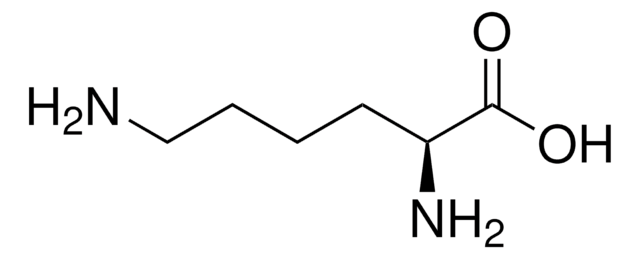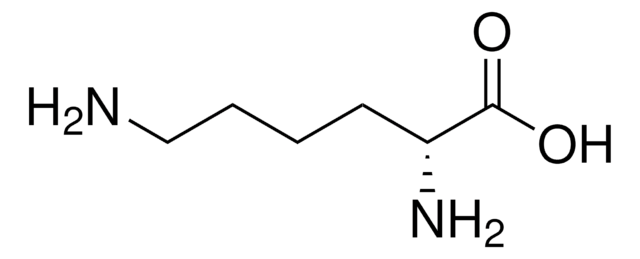62840
L-Lysine
≥98.0% (NT), for peptide synthesis
Synonym(s):
(S)-2,6-Diaminocaproic acid
About This Item
Recommended Products
product name
L-Lysine, crystallized, ≥98.0% (NT)
Quality Level
Assay
≥98.0% (NT)
form
solid
optical activity
[α]20/D +26.0±1.0°, c = 2% in 6 M HCl
quality
crystallized
reaction suitability
reaction type: solution phase peptide synthesis
impurities
≤1% water
mp
215 °C (dec.) (lit.)
~215 °C (dec.)
solubility
H2O: 0.1 g/mL, clear, colorless to very faintly greenish-yellow
application(s)
peptide synthesis
SMILES string
NCCCC[C@H](N)C(O)=O
InChI
1S/C6H14N2O2/c7-4-2-1-3-5(8)6(9)10/h5H,1-4,7-8H2,(H,9,10)/t5-/m0/s1
InChI key
KDXKERNSBIXSRK-YFKPBYRVSA-N
Looking for similar products? Visit Product Comparison Guide
General description
Application
Storage Class Code
11 - Combustible Solids
WGK
WGK 1
Flash Point(F)
Not applicable
Flash Point(C)
Not applicable
Personal Protective Equipment
Choose from one of the most recent versions:
Already Own This Product?
Find documentation for the products that you have recently purchased in the Document Library.
Customers Also Viewed
Protocols
Separation of L-Alanine; Glycine; L-Valine; L-Leucine; L-Isoleucine; L-Proline; L-Methionine; L-Serine; L-Threonine; L-Phenylalanine; L-Aspartic acid; L-4-Hydroxyproline; L-Cysteine; L-Glutamic acid; L-Asparagine; L-Lysine; L-Glutamine; L-Histidine; L-Tyrosine; L-Tryptophan; L-Cystine
Our team of scientists has experience in all areas of research including Life Science, Material Science, Chemical Synthesis, Chromatography, Analytical and many others.
Contact Technical Service


